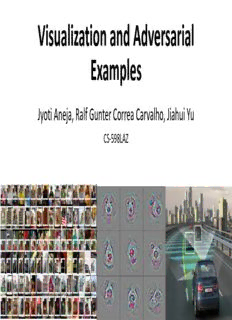
Visualization and Adversarial Examples PDF
Preview Visualization and Adversarial Examples
Visualization and Adversarial Examples Jyoti Aneja, Ralf Gunter Correa Carvalho, Jiahui Yu CS-598LAZ 1 Today’s Talk Adversarial Visualization Examples 1. Adversarial and Rubbish examples 2. Evolutionary approach 1. What is Visualization? 3. Gradient based approaches 2. Visualize patches that maximally activate neurons 4. Adversarial training 5. Transferability 3. Visualize the weights 6. Universal Adversarial Perturbations 4. Gradient based approaches 7. Why are neural networks easily fooled? 5. Optimization based approach 8. Proposed Solutions for adversarial attack 2 Outline - Visualization • What is Visualization? • Visualize patches that maximally activate neurons • Visualize the weights • Gradient based approaches • Optimization based approach 3 What is visualization? Mapping between a neuron in a layer to the features in the image. 4 Feature Maps Activations Background Check! (227 x 227 x 96) Input Image (227 x 227 x 3) Filters/Weights/Kernels Max Pool Layer (eg: 96 , 11 x 11 x 3) Neuron (Each small square) 5 What is visualization? Mapping between a neuron in a layer to the features in the original image. Backpropagation : How does the loss change with weights? Visualization : How does the activation of a particular neuron change when we change a part in the image? 6 Why visualization? • Understand how and why neural networks work • Observe the evolution of features during training • Aid the development of better models (rather than just trial-and-error) • Diagnose potential problems with the model 7 Outline - Visualization • What is Visualization? • Visualize patches that maximally activate neurons • Visualize the weights • Gradient based approaches • Optimization based approach 8 Visualize patches that maximally activate neurons Rich feature hierarchies for accurate object detection and semantic segmentation – Girshick, et al - 2013 9 Visualize patches that maximally activate neurons Rich feature hierarchies for accurate object detection and semantic segmentation – Girshick, et al - 2013 10
Description: